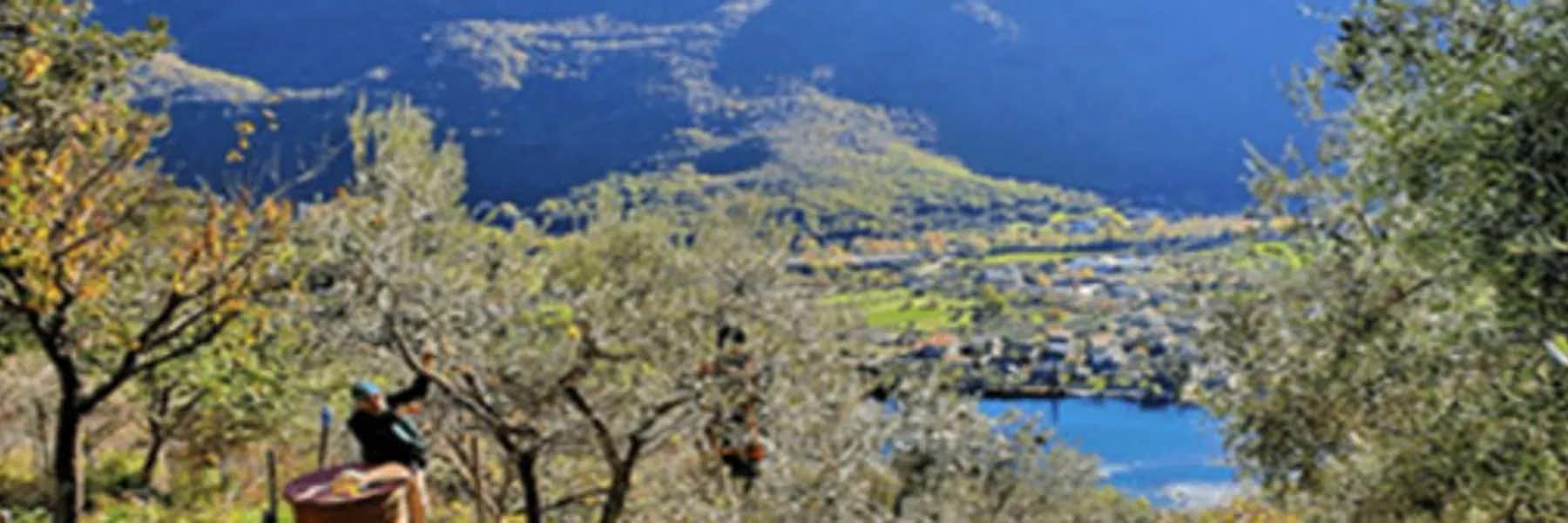We start at 7 a.m. The first arrival is 66-year-old Marcello, who pulls the fine-mesh nets under the trees that are to be harvested that morning. Olives are a precious commodity, so while there’s a degree of lightness about having me and my wife, Shonna, join in, there’s a seriousness to the business too. It takes about 10 pounds of olives to produce a liter (about four cups) of oil, so each shining fruit is precious. The trees are treated with care, and after the olives are picked, the branches are pruned to let more sun in for next year’s harvest. By the time everyone has arrived, there are seven of us, from five years old up to me at 72.
The olive harvest is a particular time in Italy, and harvesting olives is a centuries-old tradition. In Puglia and Basilicata, I have seen trees 2,000 years old—gnarled, knotted, and twisted into beautiful shapes—that still yield a crop of the delicacy traded by Phoenicians 1,000 years before that. Even where I live in Rieti, the stories of the land around the lake below Paterno go back 3,500 years. The trees are likely not that old, but the traditions might be.
The air is brisk, even cold, but we warm up soon enough. Stretching, pulling, lifting, climbing in the tree you are harvesting. With your olive rake in one hand and a branch in the other, you pull the rake through the leaves, stripping the olives and sending them into the net below.
The olive rake looks like a child’s plastic garden tool, but it is perfect for this job. The bright yellow tongs are wide enough to let the branch and leaves slip through, but catch and pull the olives off at the same time.
Somewhere between 10 and 11 a.m., someone magically shows up with a café and a cornetto or pasticcere (coffee and a pastry). Everyone takes a break to swap lies about harvesting prowess and how much they have done. Then it’s back to work.
Gradually the nets fill with the small violet-black olives this region is known for. As the morning goes on, I find myself having to stretch more, go higher, or farther out for those last few olives.
Soon enough, between 1 and 2 p.m., it’s lunchtime. I can smell the grill starting up, and the change is welcome. The table is set, and the food arrives. The harvest is a community event; our neighbors help pick our olives, we help pick theirs. People bring food and wine, and everyone will get a part of the harvest.
There is something about participating in a ritual that is thousands of years old which connects you to the land and people.The ritual is thousands of years old.Everyone is happy, and our lunch of grilled sausage, chicken, local vegetables, cheese, prosciutto, bread, and wine is not hurried. There’s ample time for more toasts, more smiles, laughter, and more lies. There is enough work to last a few weeks, and the harvest this year is excellent.
Often after coffee or lunch, someone starts a song while they work. Sometimes others join in a lusty, laughing version of songs I recognize, but with lyrics I do not understand. When they’re done, I start a song in English or attempt my version of “Volare.” It is not essential that you have a good voice, only that you participate. This is true of much of Italian society.
At the end of the day, the olives are gathered and crated. Children carry their small buckets, brimming with olives, to a crate that they fill. The young men lug the bins up and down the hills, and gradually you have 10, 15, or 20 boxes ready for the press.
We choose a cold press, run in the same place by the same family whose ancestors go back almost 800 years. It’s 20 minutes down the road, near the quarry that supplied the marble for the tombs of both John F. Kennedy and Cleopatra—quite the client list. All-in-all, after about five days of work, we load 430 kilos of olives (about 930 pounds) into the press.
From that, Shonna and I got two liters of precious oil—our share corresponding to the number of trees on our property. It is opaque, unfiltered, and yellow-green in color, with a slightly bitter, silky olive flavor. Aside from being delicious on a salad or bruschetta (toasted bread), the oil is exceptionally healthy, and goes well on anything from grilled vegetables, to steak, to Caprese salad. The work, the camaraderie, and the time spent is well worth the effort and the result.
Essentially, we took two weeks working in two different places; in the olive groves on the steep slope below our home and at our friend’s terraces above Lago Paterno.
Harvesting olives is part of a tradition that goes back before the time of Christ. It gives us great joy. Maybe it’s a connection to the centuries of humanity before us that have shared the same toil, but the work centers you, making you feel part of nature and the land, something bigger than yourself and the community.
Related Articles
Best Places to Live in Italy From $1,700 Per Month
